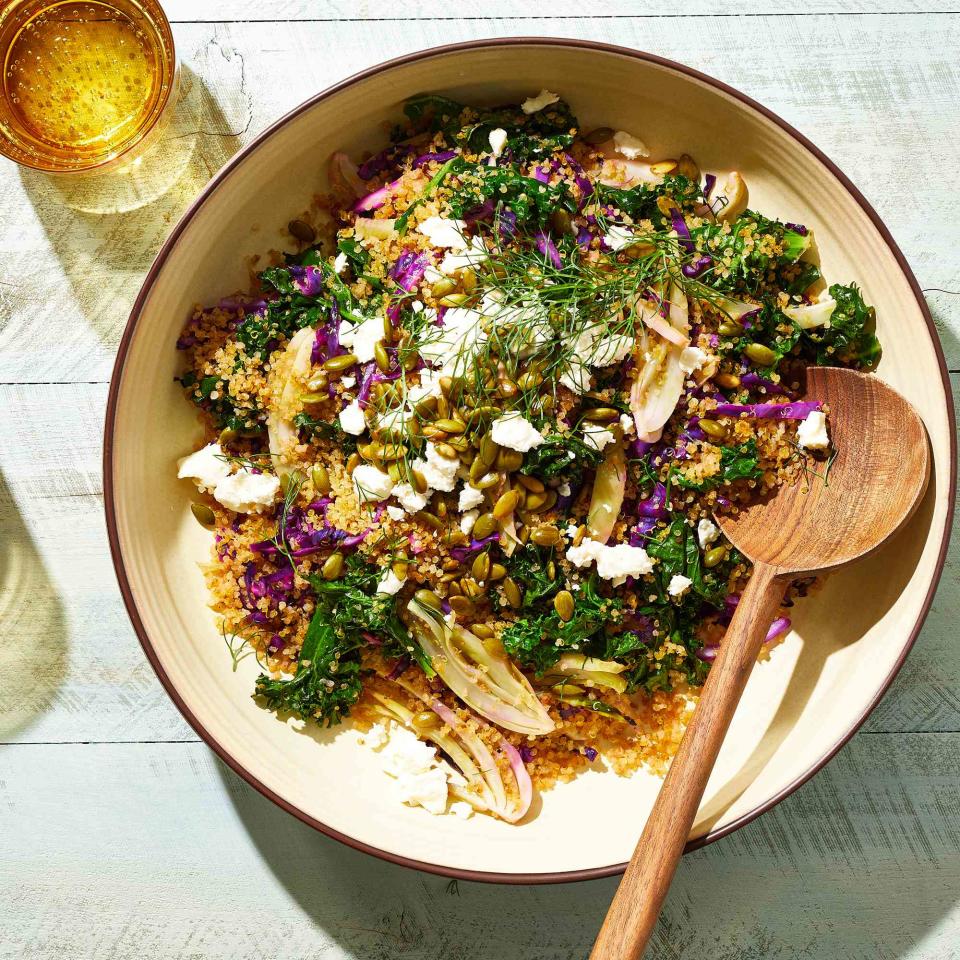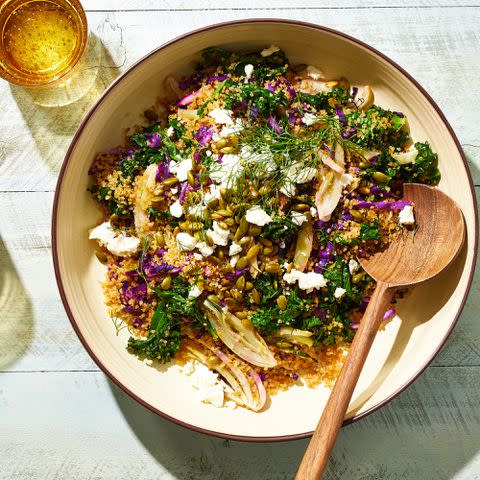6 High-Protein Grains to Add to Your Pantry, According to a Dietitian
These six whole grains are high in protein and make great pantry staples. Stock your pantry with these grains to whip up a healthy dinner in a pinch.

Reviewed by Dietitian Jessica Ball, M.S., RD
Many people are surprised to learn that grains are a significant source of protein. Although they are primarily carbohydrates, many whole grains also contain plenty of plant-based protein, a nutrient that is crucial for muscle health, bone health, healthy digestion and more. Not only that, protein contributes to satiety, keeping you full long after eating. It also plays a role in regulating blood sugar after a meal and keeping energy levels high and consistent.

Pictured Recipe: Baked Kale Salad with Crispy Quinoa
Why it's important to eat whole grains
"Whole grains are a great source of fiber, which is important for digestion and gut health, as well as prebiotics, which help support the healthy bacteria in our digestive system," says Megan Hilbert, M.S., RDN, of Top Nutrition Coaching. "Only 5% of Americans reach their daily fiber needs, so adding in whole grains can give you a boost and help you hit the recommended 25-35 grams per day," adds Hilbert.
Whole grains are also filled with protein and a variety of vitamins and minerals, including B vitamins, folate, iron and zinc. These nutrients play different roles in metabolism, energy levels and nervous system function. What's more, research suggests that eating more whole grains is linked to a lower risk of heart disease, type 2 diabetes and even cancer.
Having a well-stocked pantry with plenty of whole grains can make it easier to prepare healthy meals in a pinch. Whole grains are budget-friendly, easy to cook and fit into a variety of recipes. Stock your pantry with these six high-protein grains so you always have the beginnings of a high protein tasty meal.
1. Quinoa
Quinoa is probably the most well-known grain on the list, but you may not know that it's actually a seed. Still, the Whole Grains Council recognizes quinoa as a whole grain, and it serves up 8 grams of protein per cup cooked. "It's a great source of folate, magnesium, zinc and iron which play a really important role in cellular function and energy, and it's really easy to swap into rice-based dishes for extra nutrition," says Hilbert. Quinoa is a gluten-free grain with a nutty flavor. It's often used as the base for grain salads, and it makes a great substitute for pasta or rice in a casserole. You can also add it to vegetable soups for a protein boost.
2. Wild rice
Believe it or not, wild rice is not rice, but rather a wild-grown grass. It has 6.5 grams of protein per cup cooked, and it has a very nutty flavor. "Wild rice a great source of manganese, phosphorus, and zinc, and has a really lovely chewy texture," says Hilbert.
Cooking wild rice takes about 50 to 60 minutes, which is a bit longer than white or brown rice. More often than not, wild rice is found in a blend with other rices or grains. Wild rice can serve as the base for a simple pilaf, and it also makes a great addition to soups, stuffing and hash.
3. Amaranth
Amaranth is a tiny protein-packed grain with an interesting texture. When cooked, it's soft, like a polenta or porridge. But it can also be popped like popcorn and added to cereals and granola. Amaranth has an impressive nutrient profile, with 9 grams of protein in a cup cooked. It also contains the amino acid lysine, which is missing from most grains. Rather than use amaranth as the base for a salad or grain bowl, try mixing it into oatmeal or a pudding.
4. Sorghum
Sorghum doesn't get the love it deserves. This hearty inexpensive grain has a whopping 20 grams of protein in 1 cup cooked, and it also contains magnesium, iron, B vitamin, potassium and fiber. It's gluten-free and has a chewy texture. It's a staple food in certain parts of the world, like India and Africa, but sorghum is still underutilized in the United States.
To cook sorghum, boil uncovered for 50 to 60 minutes. It's the perfect base for a grain bowl or complement to a hearty salad. You can also use it as a replacement for pearled couscous in any dish. Like amaranth, you can also pop it like popcorn and enjoy the crunchy texture.
5. Teff
Teff is the smallest grain in the world. Although it's tiny, it has a mighty nutrition profile, with 10 grams of protein per one cup cooked. Teff also has plenty of calcium, vitamin B6, zinc, iron, magnesium and fiber. When cooked, teff has a soft consistency, similar to cream of wheat. It cooks in just 15 to 20 minutes and can be used for polenta, casseroles or veggie burgers. Teff flour also lends itself to baked goods, like brownies, cookies and breads.
6. Farro
Farro is an ancient grain that is no stranger to numerous dishes that are popular across the globe, including in the Mediterranean region. One cup of cooked farro has 12 grams of protein, and it also contains iron and fiber. Farro has a chewy texture, and it's slightly bigger than barley. It cooks in about 30 minutes and makes the perfect hearty grain for a salad or pairing it with a protein. Farro can also be used as a replacement for rice in risotto.
The bottom line
Whole grains are a good source of plant-based protein, as well as other vitamins, minerals and fiber. They can be the star of a dish, like a grain bowl or salad, or make a nice accompaniment to a protein. Many whole grains even work in breakfast cereals, granola, polenta and desserts. Stock your pantry with these six whole grains to add more muscle-building protein to your weekly meal plan.

